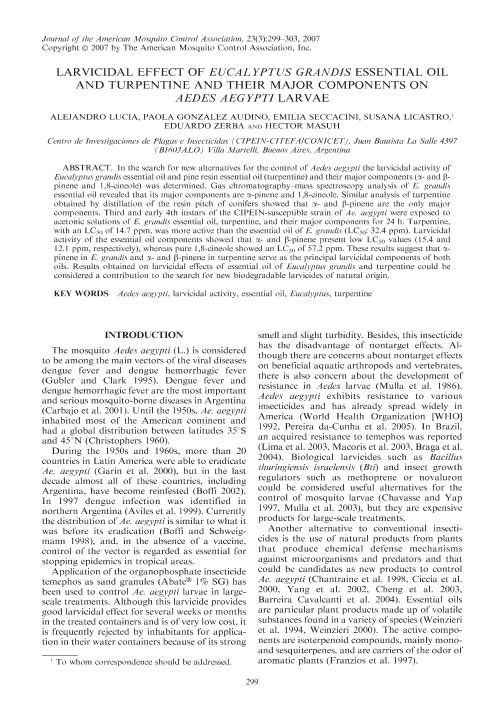Mostrar el registro sencillo del ítem
dc.contributor.author
Lucia, Alejandro

dc.contributor.author
Gonzalez Audino, Paola Andrea

dc.contributor.author
Seccacini, Emilia Ana

dc.contributor.author
Licastro, Susana Mónica

dc.contributor.author
Zerba, Eduardo Nicolás

dc.contributor.author
Masuh, Hector Mario

dc.date.available
2019-09-02T19:41:57Z
dc.date.issued
2007-09
dc.identifier.citation
Lucia, Alejandro; Gonzalez Audino, Paola Andrea; Seccacini, Emilia Ana; Licastro, Susana Mónica; Zerba, Eduardo Nicolás; et al.; Larvicidal effect of Eucalyptus grandis essential oil and turpentine and their major components on Aedes aegypti larvae; American Mosquito Control Association; Journal of the American Mosquito Control Association; 23; 3; 9-2007; 299-303
dc.identifier.issn
8756-971X
dc.identifier.uri
http://hdl.handle.net/11336/82757
dc.description.abstract
In the search for new alternatives for the control of Aedes aegypti the larvicidal activity of Aedes aegypti the larvicidal activity of Eucalyptus grandis essential oil and pine resin essential oil (turpentine) and their major components (a- and bpinene and 1,8-cineole) was determined. Gas chromatography–mass spectroscopy analysis of E. grandis essential oil and pine resin essential oil (turpentine) and their major components (a- and bpinene and 1,8-cineole) was determined. Gas chromatography–mass spectroscopy analysis of E. grandis essential oil revealed that its major components are a-pinene and 1,8-cineole. Similar analysis of turpentine obtained by distillation of the resin pitch of conifers showed that a- and b-pinene are the only major components. Third and early 4th instars of the CIPEIN-susceptible strain of Ae. aegypti were exposed to acetonic solutions of E. grandis essential oil, turpentine, and their major components for 24 h. Turpentine, with an LC50 of 14.7 ppm, was more active than the essential oil of E. grandis (LC50: 32.4 ppm). Larvicidal activity of the essential oil components showed that a- and b-pinene present low LC50 values (15.4 and 12.1 ppm, respectively), whereas pure 1,8-cineole showed an LC50 of 57.2 ppm. These results suggest that apinene in E. grandis and a- and b-pinene in turpentine serve as the principal larvicidal components of both oils. Results obtained on larvicidal effects of essential oil of Eucalyptus grandis and turpentine could be considered a contribution to the search for new biodegradable larvicides of natural origin.
dc.format
application/pdf
dc.language.iso
eng
dc.publisher
American Mosquito Control Association

dc.rights
info:eu-repo/semantics/openAccess
dc.rights.uri
https://creativecommons.org/licenses/by-nc-sa/2.5/ar/
dc.subject
Aedes Aegypti
dc.subject
Larvicidal Activity
dc.subject
Essential Oil
dc.subject
Eucalyptus
dc.subject.classification
Otras Ciencias Naturales y Exactas

dc.subject.classification
Otras Ciencias Naturales y Exactas

dc.subject.classification
CIENCIAS NATURALES Y EXACTAS

dc.title
Larvicidal effect of Eucalyptus grandis essential oil and turpentine and their major components on Aedes aegypti larvae
dc.type
info:eu-repo/semantics/article
dc.type
info:ar-repo/semantics/artículo
dc.type
info:eu-repo/semantics/publishedVersion
dc.date.updated
2019-08-26T18:37:19Z
dc.journal.volume
23
dc.journal.number
3
dc.journal.pagination
299-303
dc.journal.pais
Estados Unidos

dc.description.fil
Fil: Lucia, Alejandro. Consejo Nacional de Investigaciones Científicas y Técnicas. Instituto de Investigaciones Científicas y Técnicas para la Defensa. Centro de Investigación de Plagas e Insecticidas; Argentina
dc.description.fil
Fil: Gonzalez Audino, Paola Andrea. Consejo Nacional de Investigaciones Científicas y Técnicas. Instituto de Investigaciones Científicas y Técnicas para la Defensa. Centro de Investigación de Plagas e Insecticidas; Argentina
dc.description.fil
Fil: Seccacini, Emilia Ana. Consejo Nacional de Investigaciones Científicas y Técnicas. Instituto de Investigaciones Científicas y Técnicas para la Defensa. Centro de Investigación de Plagas e Insecticidas; Argentina
dc.description.fil
Fil: Licastro, Susana Mónica. Consejo Nacional de Investigaciones Científicas y Técnicas. Instituto de Investigaciones Científicas y Técnicas para la Defensa. Centro de Investigación de Plagas e Insecticidas; Argentina
dc.description.fil
Fil: Zerba, Eduardo Nicolás. Consejo Nacional de Investigaciones Científicas y Técnicas. Instituto de Investigaciones Científicas y Técnicas para la Defensa. Centro de Investigación de Plagas e Insecticidas; Argentina
dc.description.fil
Fil: Masuh, Hector Mario. Consejo Nacional de Investigaciones Científicas y Técnicas. Instituto de Investigaciones Científicas y Técnicas para la Defensa. Centro de Investigación de Plagas e Insecticidas; Argentina
dc.journal.title
Journal of the American Mosquito Control Association

dc.relation.alternativeid
info:eu-repo/semantics/altIdentifier/doi/https://doi.org/10.2987/8756-971X(2007)23[299:LEOEGE]2.0.CO;2
dc.relation.alternativeid
info:eu-repo/semantics/altIdentifier/url/https://bioone.org/journals/journal-of-the-american-mosquito-control-association/volume-23/issue-3/8756-971X(2007)23%5b299%3aLEOEGE%5d2.0.CO%3b2/LARVICIDAL-EFFECT-OF-EUCALYPTUS-GRANDIS-ESSENTIAL-OIL-AND-TURPENTINE-AND/10.2987/8756-971X(2007)23[299:LEOEGE]2.0.CO;2.short
Archivos asociados
